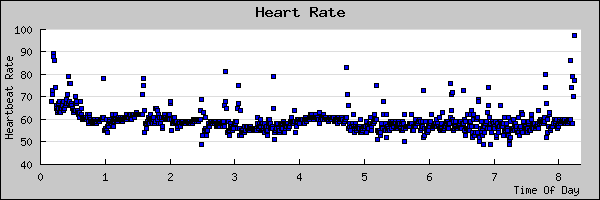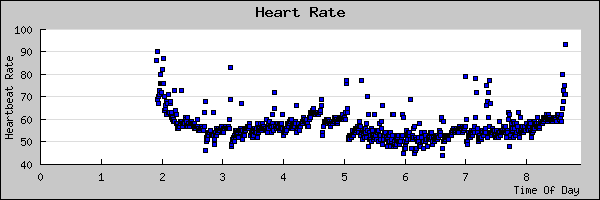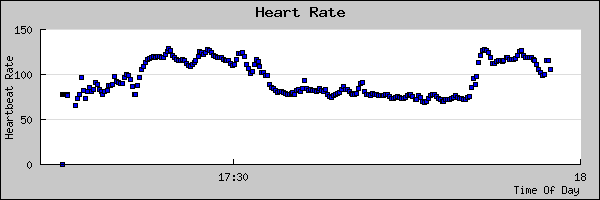Last month we played host to our project partners in REFLECT, an EU research project aimed at the development of pervasive-adaptive systems (NB. Ferrari + heart monitor = awesome). For the evening festivities a Shiverpool tour was arranged. Shiverpool is a Liverpool based theatre performance in which the audience is taken on a night tour of the city by a spirit guide who regales his audience with stories about Liverpool’s supernatural past. The guide is also accompanied by several ghoulish friends (or fiends, depending if your the target of the next scare or not). To add a little bit more spice to the evening we brought along the heart monitors and wired up five members of our group to see once more Who’s afraid of Ghost Stories? Unfortunately not everything went to plan, we had a few issues with the hardware causing a significant level of data loss preventing a detailed commentary about individual responses as was done with Ghost Stories, so instead I thought it would a good time to talk about the heart monitors we use and the software platform that runs The Body Blogger which we used for this event. Continue reading
Tag Archives: wireless
Mobile Monitors and Apps for Physiological Computing
I always harbored two assumptions about the development of physiological computing systems that have only become apparent (to me at least) as technological innovation seems to contradict them. First of all, I thought nascent forms of physiological computing systems would be developed for desktop system where the user stays in a stationary and more-or-less sedentary position, thus minimising the probability of movement artifacts. Also, I assumed that physiological computing devices would only ever be achieved as coordinated holistic systems. In other words, specific sensors linked to a dedicated controller that provides input to adaptive software, all designed as a seamless chain of information flow.
iBrain
I just watched a TEDMED talk about the iBrain device via this link on the excellent Medgadget resource. The iBrain is a single-channel EEG recording collected via ‘dry’ electrodes where the data is stored in a conventional handheld device such as a cellphone. In my opinion, the clever part of this technology is the application of mathematics to wring detailed information out of a limited data set – it’s a very efficient strategy.
The hardware looks to be fairly standard – a wireless EEG link to a mobile device. But its simplicity provides an indication of where this kind of physiological computing application could be going in the future – mobile monitoring for early detection of medical problems piggy-backing onto conventional technology. If physiological computing applications become widespread, this kind of proactive medical monitoring could become standard. And the main barrier to that is non-intrusive, non-medicalised sensor development.
In the meantime, Neurovigil, the company behind the product, recently announced a partnership with Swiss pharmaceutical giants Roche who want to apply this technology to clinical drug trials. I guess the methodology focuses the drug companies to consider covert changes in physiology as a sensitive marker of drug efficacy or side-effects.
I like the simplicity of the iBrain (1 channel of EEG) but speaker make some big claims for their analysis, the implicit ones deal with the potential of EEG to identify neuropathologies. That may be possible but I’m sceptical about whether 1 channel is sufficient. The company have obviously applied their pared-down analysis to sleep stages with some success but I was left wondering what added value the device provided compared to less-intrusive movement sensors used to analyse sleep behaviour, e.g. the Actiwatch
Who's afraid of Ghost Stories?
Last Saturday Steve and I went to see Ghost Stories over at the Playhouse theatre in Liverpool. The performance acts out a series of ghost stories a paranormal investigator has collected during his research into the supernatural. As one can imagine the aim of such an experience is to provide the audience with a good scare. To make things a little more interesting we decided to wire ourselves up and monitor the changes in our heartbeat during the performance thereby allowing us to compare our subjective experiences with our own physiological reactions. The results provide an interesting look into how our expectations of the event met with its reality as demonstrated by the recorded changes in our heartbeat.
Before continuing, consider this your SPOILER warning. If you haven’t seen Ghost Stories and intend to see it at the Lyric I suggest you hold off for now as I am going to have to give away some of the plot in order to explain events in their proper context. If you’ve already seen Ghost Stories or don’t intend to then continue on and see who indeed was afraid of the Ghost Stories.
Continue reading
Who’s afraid of Ghost Stories?
Last Saturday Steve and I went to see Ghost Stories over at the Playhouse theatre in Liverpool. The performance acts out a series of ghost stories a paranormal investigator has collected during his research into the supernatural. As one can imagine the aim of such an experience is to provide the audience with a good scare. To make things a little more interesting we decided to wire ourselves up and monitor the changes in our heartbeat during the performance thereby allowing us to compare our subjective experiences with our own physiological reactions. The results provide an interesting look into how our expectations of the event met with its reality as demonstrated by the recorded changes in our heartbeat.
Before continuing, consider this your SPOILER warning. If you haven’t seen Ghost Stories and intend to see it at the Lyric I suggest you hold off for now as I am going to have to give away some of the plot in order to explain events in their proper context. If you’ve already seen Ghost Stories or don’t intend to then continue on and see who indeed was afraid of the Ghost Stories.
Continue reading
Wireless Heart Monitoring Trials
I’m currently working on a project over at LJMU (among other things) involving wireless heart monitoring. The project goes live later this month so I’ll talk more about it then but for the time here are some snapshots of my physiology in situations I don’t normally get to record with the “wired to my desktop” setup
In figures 1 and 2 each plot represents one minute of averaged heartbeat rate. Just as a side note my heartbeat rate at rest is typically in the 60-70 bpm range.
Figure 1– Sleep Cycle: Heartbeat rate from 12am to 9am on 07-02-10
Figure 2 – Sleep Cycle: Heartbeat rate from 2am to 9am on 08-02-10
Figure 3 – Travel from the Office to Home
In Figure 3 each plot represents 10 seconds of average heartbeat rate. As you can see when I leave the office I start with a HR of ~70 bpm. But then it skyrockets to ~120 bpm as I walk home. Walking being the subjective term here. I guess the monitor would say I’m more jogging than running. As I reach the train station at 17:35 my heart rate returns to its rest state until I get off the train at 17:45.
EDIT:
The wireless heart monitoring project can be found at The Body Blogger. The project involves the 24×7 recording of my physiological changes which are shared in real-time with this website and twitter. I recently did a talk at Quantified Self London about my experiences as The Body Blogger for which we now have a video.
Cross-posted at http://justkiel.blogspot.com


